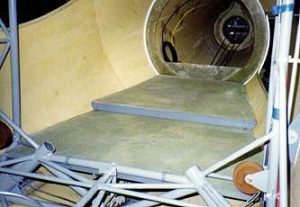
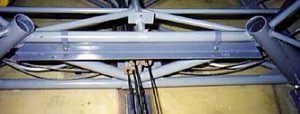 A flat floor in the baggage area has several advantages. Much more room is available underneath for placement of electrical wires and components (such as the strobe power supply) and for avionics cables and antennas. A determined traveler can sleep in the airplane. And large cargo items may be placed and secured more easily. One drawback is a little less useable space, which is hardly a problem in a GlaStar. Another is the necessity for a strong floor to protect the underlying rudder and elevator cables.
A flat floor in the baggage area has several advantages. Much more room is available underneath for placement of electrical wires and components (such as the strobe power supply) and for avionics cables and antennas. A determined traveler can sleep in the airplane. And large cargo items may be placed and secured more easily. One drawback is a little less useable space, which is hardly a problem in a GlaStar. Another is the necessity for a strong floor to protect the underlying rudder and elevator cables.
 I decided to use a composite floor for its good strength-to-weight ratio. Stoddard-Hamilton suggests plywood which is heavier. Also, the idea of having wood in a GlaStar somehow bothers me. The factory does have a good idea in dividing the baggage space fore and aft for weight and balances purposes. I incorporated a slight vertical joggle as a dividing line which also serves to reinforce the center of the span.
I decided to use a composite floor for its good strength-to-weight ratio. Stoddard-Hamilton suggests plywood which is heavier. Also, the idea of having wood in a GlaStar somehow bothers me. The factory does have a good idea in dividing the baggage space fore and aft for weight and balances purposes. I incorporated a slight vertical joggle as a dividing line which also serves to reinforce the center of the span.
 The floor consists of 3/8″ Divinylcell foam (available from Aircraft Spruce) with one layer of bid on each side. Aluminum angle (1″ X 1″), held to the cage by two plain clamps, supports the floor at the forward edge. The floor is lower than the cage crosstube which then provides a forward stop for cargo. The rear edge rests on two smaller pieces of angle held to bulkhead A with #10 screws, large washers and elastic nuts. These were located vertically to keep the floor clear of the cables.
The floor consists of 3/8″ Divinylcell foam (available from Aircraft Spruce) with one layer of bid on each side. Aluminum angle (1″ X 1″), held to the cage by two plain clamps, supports the floor at the forward edge. The floor is lower than the cage crosstube which then provides a forward stop for cargo. The rear edge rests on two smaller pieces of angle held to bulkhead A with #10 screws, large washers and elastic nuts. These were located vertically to keep the floor clear of the cables.
 Using a temporary fore-aft angle for reference, the middle pair of side flanges was laid-up with two layers of DBM. The crosswise angle was set using a digital level, assuming that the fuselage is level to begin with. Then using even more temporary angles the aft and forward pairs of side brackets were placed for a total of three along each side of the fuselage. Note that the aft side and rear brackets are an inch or so higher to accommodate the joggle. All the supporting angles and flanges have #10 nutplates installed.
Using a temporary fore-aft angle for reference, the middle pair of side flanges was laid-up with two layers of DBM. The crosswise angle was set using a digital level, assuming that the fuselage is level to begin with. Then using even more temporary angles the aft and forward pairs of side brackets were placed for a total of three along each side of the fuselage. Note that the aft side and rear brackets are an inch or so higher to accommodate the joggle. All the supporting angles and flanges have #10 nutplates installed.
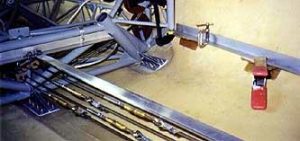 Cardboard templates were trimmed to the shell contour and then used to cut the two composite pieces. While the side edges are beveled to match the fuselage sides, I left a small gap to prevent the floor from working against the shell. Light carpeting will cover the gaps.
Cardboard templates were trimmed to the shell contour and then used to cut the two composite pieces. While the side edges are beveled to match the fuselage sides, I left a small gap to prevent the floor from working against the shell. Light carpeting will cover the gaps.
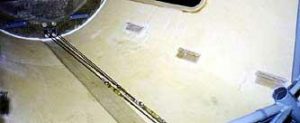 The joggle consists of an angle along the aft edge of the forward baggage floor which is held in place by milled fiber and one layer of bid. The aft floor’s forward edge has a similar angle which overlaps the forward floor’s. Three screws and nutplates hold them together. Each section of floor will hold my 160 lb. on the ball of one foot without any noticeable deflection. But just to be sure, I attached two 2″ fore-aft stiffeners to the underside of the forward floor. This piece is really rigid now.
The joggle consists of an angle along the aft edge of the forward baggage floor which is held in place by milled fiber and one layer of bid. The aft floor’s forward edge has a similar angle which overlaps the forward floor’s. Three screws and nutplates hold them together. Each section of floor will hold my 160 lb. on the ball of one foot without any noticeable deflection. But just to be sure, I attached two 2″ fore-aft stiffeners to the underside of the forward floor. This piece is really rigid now.
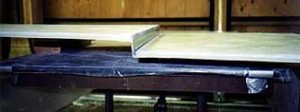 The finished floor, including the angles and stiffeners, weighs a little under 5 lb. I plan to make plastic or composite closeouts for the lower triangles of the cage to protect the pulleys. Otherwise the baggage floor and seat pans cover everything. My front floorboards are made of the same composite materials.
The finished floor, including the angles and stiffeners, weighs a little under 5 lb. I plan to make plastic or composite closeouts for the lower triangles of the cage to protect the pulleys. Otherwise the baggage floor and seat pans cover everything. My front floorboards are made of the same composite materials.

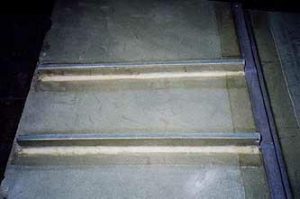



Any chance of getting the pictures back on this article?
Yes – fixed.